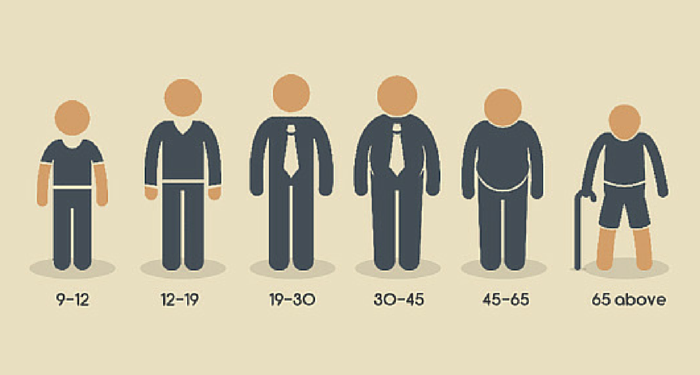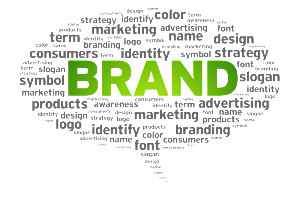How to Make Your Brand Stand Out in a Crowd
On a hot Monday afternoon, July 4th, 2016, competitors will gather at the boardwalk on Coney Island in Brooklyn, N.Y. to compete in one of the most famous Indepedence Day traditions around – the Nathan’s Hot Dog Eating Contest. Now, despite what some may think of the contest itself, there is little doubt the impact it has had on the Nathan’s Famous Hot Dog brand.
This was a brand that was previously only known to a select few in the northeast, but is now known around the world. And much of the thanks for that comes from those who showed up every  Fourth of July in front of the brand’s Coney Island location to see how many hot dogs they could eat in ten minutes.
Fourth of July in front of the brand’s Coney Island location to see how many hot dogs they could eat in ten minutes.
That’s right – a brand was able to build an entire branding strategy off of a competitive eating contest.
How did they do it? This situation is a classic example of a brand seeing an unmet need and filling the space.
There normally isn’t a lot going on in terms of televised entertainment on this day of the year, and the company had been holding hot dog eating competitions for many years. With the foresight to see the potential behind filling the entertainment void, Nathan’s then was able to connect their brand with the holiday in general. As the competition’s popularity grew, so did the brand recognition and brand equity.
For brands looking to stand out in a crowded marketplace, looking for ways to reach outside of just your product can be the most effective way to differentiate from your competitors. Nathan’s was sitting in the packed hot dog-selling industry, with little brand separation, especially when competing against the bigger brands in its space.
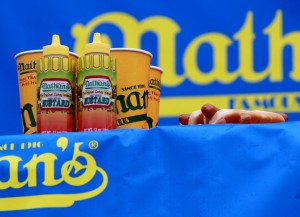 They didn’t look to try and create a fancy new logo or change their brand values – instead, they used the local strength of their brand and a timely piece of entertainment connected with their product to gradually build up.
They didn’t look to try and create a fancy new logo or change their brand values – instead, they used the local strength of their brand and a timely piece of entertainment connected with their product to gradually build up.
An important point to keep in mind, however, is that a quality product behind the brand is a vital piece of the puzzle. There is little doubt that if Nathan’s sold an inferior hot dog that didn’t stand up to the reputation of the brand, then its growth and reputation would be limited.
Let’s assume you are offering a high-quality product in a crowded space where your brand is struggling to stand out. You may not have something unique as the hot dog eating contest to help grow your brand, but your brand is so much more than its tangible assets.
Maybe your customer satisfaction is astoundingly good? Maybe you have a strong connection to a season, place or feeling? Or possibly your brand is synonymous with a particular event, much like the Nathan’s example.
All of these are ways to spread your brand beyond the traditional brand limits, and find new audiences who simply needed to be made aware of your brand and what it stands for.
Image Sources:
Image 1
Image 2
Learn more about building your best brand by downloading this FREE webinar, "Identifying The Opportunities In Your Brand Portfolio - Are You Capitalizing On Every Potential Business Opportunity Your Portfolio Provides?"
The Appearance of Assortment: Why Kraft-Heinz Cross-Branded
“People achieve more as a result of working with others than against them.” -Dr. Allan Fromme
Facing a highly competitive packaged food industry and a shift in demands and drop in growth, Kraft-Heinz decided to take an offbeat-path to win consumers back. In a series of collaborative efforts with other brands, Kraft-Heinz has been able to achieve the appearance of more premium and diverse products. As the food community changes, Kraft-Heinz is changing with it.
The recent surge in the demand for products appearing natural, protein rich, or sugar free has no doubt affected the processed and packaged food aisles of your grocery store. The mounting distrust of big food companies led to a stagnant 2015 for Kraft-Heinz. But, in 2016, a new Mac ‘n Cheese product and healthy lunchable-style sandwich pack gave Kraft-Heinz’s brand the pick-me-up it needed.
Kraft Mac ‘n Cheese was a product losing momentum and credibility as consumers started looking suspiciously at the product once viewed as a “convenient dinner option.” After collaborating with Cracker Barrel, Kraft-Heinz released a new line of Mac ’n Cheese made with premium “Cracker Barrel award winning cheese”.
The tag line title made to say “you may not have liked our old cheese, but check out this shiny new cheese, it has won cheese awards!” By isolating an element of their product, and substituting it with the same element from another reputable brand, Kraft Mac ‘n Cheese looks a little less scary in the eyes of the consumer.
But not all cross branding efforts necessarily have to be the collaboration of a “better” or more premium version of a product to make it seem improved. Kraft-Heinz’s release of the “P3”packs, a protein packed twist on the traditional Lunchables feature packaging, which boldly advertises both the Oscar Meyer and Planters brands, is an example of a new branded product that is an equal collaboration. Although neither brand is any more or less reputable than the Kraft brand, the diversity created by using the equity of two brands gives the appearance of a superior product.
Variegating its products with similar or better brands makes Kraft-Heinz look more appealing in the less popular packaged food aisle, even if they’re collaborating with other packaged food. Two seems to be consistently better than one in the eyes of an untrusting consumer. Kraft Heinz’s 0.2 percent increase in U.S. sales to $4.7 billion from the first-quarter since the release of the “P3” packs to back up this phenomenon, after 2 years of declining sales. Tying in another brand freed Kraft-Heinz from a potentially dangerous product rut.
But why is that? Do buyers feel as if brands put more effort into products born from a multi-branded collaboration? Do we view a combination of brands who lack efficacy working together makes them more accountable?
Whether the new products are truly leaps and bounds improved is still up for discussion, but this was no doubt beneficial to the Kraft-Heinz brand. In a recent Trib Article author Alex Nixon adds that Kraft- Heinz’s new products” have been anything but revolutionary, but small changes can make a big difference with consumer”. If anything, it shows an implementation of strategy in creation of new product, and a targeted response to the consumer demands. Kraft-Heinz’s cross branding strategies show they’re listening, and they still care about being in the game
Next time your eyes linger on a cross branded product, allow yourself to wonder what is getting better by the collaboration of others. Let me know what you find.
Image Sources:
Image 1
Image 2
Learn more about building your best brand by downloading this FREE webinar, "Identifying The Opportunities In Your Brand Portfolio - Are You Capitalizing On Every Potential Business Opportunity Your Portfolio Provides?"
Speaking Their Language: 4 Tips in Branding for an Age Group
If a company’s message falls down in the forest with no one to hear it, did it really even make a sound?
Just like the lonely tree tipping, a brand irrelevant to its audience’s age group is non-existent. Creating a desirable brand means creating an observable one, and sometimes that means translating your message to match the desires of those you want to buy in.
The major rifts in the mindsets between age groups make this translation a necessity. A 10-year-old and a 40-year-old might both want Sharpies, but the 10-year-old will draw dragons in art class, and the 40-year old will label his Tupperware. To prevent your business’ generation gap from showing, here are four tips to guide branding for your target age group.
- Find the listeners, and those you wish were.
Know the ages of those following your company’s story and responding to your brand messaging. The scope of people you’re actually reaching shows how much work you’re going to have to do. Use customer analytics to see what ages have their eye on your business, and then decide if you want to focus in on a group of them. Know the reason a target group might want what you’re selling, and why they’re different from who’s currently buying. Once you find out what matters to them, you can show why your brand matters too. - Use what you’ve got going for you.
Hey, it’s worked so far right? You don’t have to reinvent the wheel on your brand in order to reach a specific age group; you just have to repackage it. Take what you have and put a new spin on why it's necessary to your demographic. Use the benefits you already know your brand has to offer and create specific connections in the reasons those benefits resonate with your target market. Estee Lauder was long known as a cosmetic brand for women 40-60 years old before they made Kardashian family member Kendall Jenner an official spokes-model. The brand instantly became teen friendly, without changing or adding a single product. You won’t hear this often in the business world, but find the “Kardashian” your brand needs. - Make less, more.
Make reaching the smaller sample group better than reaching the masses by presenting your brand more efficiently. Get specific, and tailor your message in a way that couldn’t be done for a catch–all group to make possible losses worth it. The criteria that motivates customers to buy ranges far and wide between ages. Once your ages get specific, the analysis of the criteria that matters to the desired age group will be more relevant and your tactics will be more successful. Sometimes effective brand strategy means making some cuts in the people groups you care about reaching. What good is a big audience if your message is not relevant or made specifically for anyone in it? - Don’t forget the other stuff.
Have you ever heard the phrase “age is just a number?” No brand can rely on one key component of a consumer’s identity to define all of their behavior. Tune in and target age groups you want to reach but leverage your strategies with the importance of other key demographics. Gender, race, socio-economic status, lifestyle and location can all make or break whether your message will be received.
Don’t let the appeal of your brand suffer due to information ill-communicated between ages. Once your brand finds its own crafted voice that speaks right into its targets ear, it will flourish stronger than yelling at the whole world. Make your sound count, just in case your company’s message ever falls down in a forest.
Learn more about building your best brand by downloading this FREE webinar, "Identifying The Opportunities In Your Brand Portfolio - Are You Capitalizing On Every Potential Business Opportunity Your Portfolio Provides?"
Living the Brand: How to Build a Strong Brand Persona
Why do we gravitate towards certain brands while actively avoiding others? What is causing the rise in “lifestyle” branding? When does a brand become something more than just a brand?
The answers to these questions could be the basis for an entire blog series, but for this one, we are going to focus on the common theme that runs throughout all of the answers: creating a brand that connects with your audience.
This strategy fits mainly with corporate and organizational branding, with less of an impact toward individual product branding. While those brands can and should still work toward emotional connectivity, the organization and corporate brand presents a more overarching opportunity to become more than just a brand to its audience.
When creating these types of brands, take stock of which characteristics rise to the top with the least amount of effort. A brand persona should come naturally, as it represents a brand’s very core of characteristics, ones that will easily be identified as being constructed and unnatural to the overall branding strategy. For smaller organizations especially, creating a brand that mirrors your personality and can become an extension of yourself can help drive it forward much more effortlessly.
It is in our nature to connect and prioritize those things we relate to, and those things we enjoy. Brands are the same way. It’s why emotional connectivity is so important for brands – their consumers will instinctively be drawn to their brand if there exists an emotional or personal connection.
From a brand perspective, it’s difficult to take steps toward connecting with the audience and presenting a brand that holds certain characteristics if it doesn’t resonate with who you are. To touch on the lifestyle brand topic, the most successful examples are those with founders/owners/executives to live the brand – for instance, if the brand persona is one of laid back, relaxed, eternal vacation living but their founder comes across as buttoned-up, consistently high-strung and stressed out, then the brand will lose emotional authenticity with its audience.
Additionally, your employees are the most prominent proponents of the brand – each day, to effectively advance the brand, they must live the persona and buy into what the brand represents. Again, an inauthentic brand character will have a negative impact that could be difficult to overcome.
So if you’re looking to create a brand that has strong emotional connectivity ability and ties in with your personality, find out what makes you, you. Likes, dislikes, lifestyle, goals, aspirations – all of these are important pieces to help determine your brand. Successfully accomplish this area of brand development, and living the brand will be as easy as living your life.
Learn more about building your best brand by downloading this FREE webinar, "Identifying The Opportunities In Your Brand Portfolio - Are You Capitalizing On Every Potential Business Opportunity Your Portfolio Provides?"
Stick With What You Know: How to Achieve a Successful Brand Extension
Stick with what you know – it’s a simple piece of advice and one that serves as the guiding force behind making an initial run with brand extension decisions. When looking to expand a brand’s influence by introducing new products in different product categories, brand extensions can be a risky move, destined to either spread the master brand to new frontiers, or bound to crash and burn, potentially harming the master brand in the process.
It’s been said before on this very blog that when it comes to brand decisions, there’s no need to recreate the wheel. Sometimes, the brand extension that makes the most sense, or the one that comes to mind first, is there for a reason – it’s the best choice. This is especially true for first-time forays into brand extensions. The issues begin when brands try to outthink themselves, reaching for products that were at the end of the brainstorming list, just to try and tap into a market in which the master brand would never be considered.
Find a product line that provides your audience with an easily traceable link to the master brand. Not only will this increase the residual brand equity for the new product, but it will also ease any apprehension when the two are inevitably linked. For instance, if your brand is known for cleaning products, then the new extensions should fall within the “cleaning” realm, no matter how indirectly that may be. This will avoid any unsavory connotations, such as attempting to sell a potato chip that people will instinctively think has cleaner in it.
The direct line advice is applied mainly when the extension is directly leveraging the master brand. While there are some extensions that step outside of the master brand’s key space, their branding efforts are set forth to establish them as individual and unique brand offerings, where the master brand is not utilized or mentioned.
Another advantage to sticking to what your brand is known for is the sense of expertise that will be felt within the audience for the extension product. If consumers already feel your brand stands out within its space, finding a product that can be closely associated with that space will further expand that feeling that if your brand can excel at one thing, then creating an industry-related product is highly believable.
As previously mentioned, these new products are bound to carry the weight of the master brand. This impact goes both ways, as well. Determine whether the success or failure of the extension could have a negative effect on the master brand. If the extension takes off and it ends up coming back to harm the master brand, than the potential harm may not outweigh the benefit of a successful product launch.
When a brand extension is on the table, it is time to look at the master brand’s strategic plan. A good brand strategy when working with multiple brands under one roof should have a well-designed, easily understood brand portfolio, where each individual brand has a logical place, while also saving room for brand extensions and expansion. Trouble can arise when an extension is introduced that does not fit properly within the portfolio. Not only can that signal that an extension is outside of the proper reach and area of expertise for a master brand, but it can also disrupt the overall brand strategy.
Still unsure whether a brand extension is the right move for your brand? Learn more by downloading this FREE webinar, "Identifying The Opportunities In Your Brand Portfolio - Are You Capitalizing On Every Potential Business Opportunity Your Portfolio Provides?"
5 Ways to Begin Your Branding Before You Begin Your Branding
As with most elements of business, preparation is a key factor to finding success. Sometimes, the work done prior to the project is just as important as the work done during. This same idea is in play during the branding process. Jumping right into a new brand development or a rebrand is akin to jumping in a pool before finding out how deep it is. Those brands who begin their branding journey by following these five steps ensure they’re starting off on the right foot.
- Take a Look Around – Who are You Talking to?
Have you ever tried to talk to a group of people who aren’t listening? It’s an exercise in futility and a waste of time. This goes for brands that don’t identify their target audiences early in the branding process. They’re stuck shouting at the masses, hoping a few will actually hear the message. Before you can start determining your messaging, you first must decide who will be most apt to listen and associate with your brand and what your brand has to say.
- Don’t Leave it All Behind.
This is especially important for those planning to begin a rebrand. As mentioned previously on this blog, just because a brand is looking to refresh doesn’t mean that everything from its past must be wiped clean. Determine what brand characteristics and aspects still hold a piece of brand equity – whether it be your name, a logo element or simply a color scheme – and keep them in mind as the new brand takes shape. They are a built-in head start in the brand equity building process, and shouldn’t be wasted.
- Find Your Sweet Spot.
“Trying to be everything to everyone means you’ll be nothing to no one.” Much like identifying a target audience, proper pre-branding branding work includes researching what makes your brand stand out, and in which space you will best thrive. Brand specialties can vary greatly, but the ones who have the most success learn what differentiates them from the competition, and make that the focal point of branding efforts. Putting your best foot forward is a valuable resource in the path to success.
- Determine Your Destination.
At this point, there is a solid foundation of information in place and the branding process is about to really begin. However, there is one more question that still needs to be answered: where does the brand want to go? Branding without a final “destination” in mind is a sure path toward failure. The end result is what will help drive the strategies and actions surrounding the branding process, and allow them to all have a single endpoint to move toward.
- A Journey of a Million Miles Begins with a Single Step.
There’s a lot that goes into branding, and it can be a bit overwhelming. But after following these steps and going into the process armed with the information and strategic knowledge to ensure an efficient and effective brand build, the next step is the easiest – it’s time to start. Don’t get caught up in everything that stands between the beginning and the finish. Instead take each step with care and attention to the details that will arise.
Looking toward the Branding Future with an Eye on the Past
It’s a common misconception that a “rebrand” automatically means a brand new start – that when a rebrand occurs, the slate must be wiped clean and all subsequent branding elements must possess totally original characteristics.
In fact, the best rebrands take the opposite approach. They take the time beforehand to identify and research what brand aspects of the previous iteration carry the most weight and provide the most benefit, then find ways to incorporate or pay homage to these aspects in the new brand.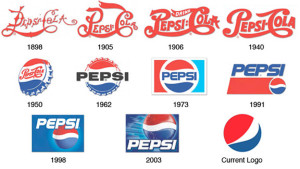
A recent example of this is the brand update from the Sacramento Kings of the NBA. As they were preparing to move to a new arena, they felt a need to update their brand, specifically their logo.
Throughout the redesign process, they looked at countless visual branding representations of the team name, many of which had little to no connection to the previous visual portfolio. However, what they kept coming back to was a design that touched on previous logos from the franchise’s long and storied past.
Ultimately, they chose a design that was a more modern version of the historical look, which immediately allowed fans, players, alumni, employees and the overall audience to connect the team’s future with its past, providing the new logo with instant brand equity.
This idea of building equity in a brand, especially within a specific element, is a difficult concept to strategize. Often it takes years to build up enough recognition, goodwill, historical weight, etc. to
sufficiently say that the brand carries its own weight with an audience. Therein likes one of the benefits of tapping into a brand’s history while strategizing its future. In this instance, those who connected with the team back when they were the Kansas City Kings or even when they were in Cincinnati, Ohio and known as the Cincinnati Royals could reconnect with the franchise through a familiar visual branding choice.
Or, as Alex Kramers of Kings.com says, “The powerful, all-encompassing symbol invoked a deep sense of nostalgia while reinvigorating a heritage that had long distinguished the historic franchise.”
This quote can resonate with brands across the spectrum as a reminder that rebranding and reinvigorating don’t have to be mutually exclusive. There’s a reason why the positive aspects of the past are so often imagined fondly, and why nostalgia is such a powerful emotional response, one that brands should be jumping at the opportunity to include.
Rebranding with an eye toward the past doesn’t have to stop at a redesigned logo. Every aspect of the brand is subject to holding nostalgic brand equity, and as such, should be included in the research process used to determine the best of the best of the old brand. It could be something as simple as a color choice that connects the branding eras, or it could go all the way up to the verbal branding and brand name that drives the association.
From start to finish, the big decisions to the smallest details, the top of the organization all the way down, a rebrand can be an overwhelming and challenging task. Why add more to the effort by starting from scratch? Use what your brand already possesses and give the new brand a ready-to-go foundation on which to build.
Don't Reinvent the Branding Wheel
Innovative. Transcendent. Groundbreaking.
Many brands would love to be associated with these characteristics, or at least have the words used as descriptions of their brands. But for some, this may not necessarily be a good thing.
As discussed in a recent study from York University in Toronto, finding the right balance of when and how much to update the brand is crucial to brands, especially those who are seen as “sincere” and whose brand perception does not include a propensity for change.
These brands have built their brand equity by tapping into the predisposition some consumers have for the familiar. These consumers want their brands and their products to feel (and look and taste and smell) the same throughout the years, and even the most minor changes can produce shock waves among the fan base.
In this case, branding efforts should make the focus more on reaffirming the standout brand qualities, taking a page from some of the world’s longest-lasting brands and highlighting what got them to this point in their journey.
However, some brands far underestimate the power of familiarity and sincerity, and find themselves caught up in the race to be the “next big thing.” Change is a process – it has to come natural and be the next smart strategic step for a brand, not something that is conjured up out of thin air, simply changing just to say they did it.
This doesn’t mean that brands that are well-established must stay stuck in the mud and not update. It’s that it needs to be a brand evolution instead of a brand reinvention. Subtle, progressive changes are necessary to stay up-to-date and capitalize on the current consumer mindset – the key is to know when it’s time for baby steps, and when it’s time for a leap of change.
On the other end of the spectrum, for those brands where innovation is second nature, the gloves are off. Consumers expect the latest and greatest at fairly regular intervals, and being synonymous with innovation comes with its own set of brand strategy best practices. For instance, in the aforementioned study, consumers saw Apple as “creative, young and exciting” and were more open to  accepting new products that brought about new product interactions.
accepting new products that brought about new product interactions.
But even Apple, who seems to be the leader in “next big thing” development, knows the power of maintaining core brand characteristics. From their iconic logo to the naming architecture of their products, the knowledge that a strong foundation is necessary to support the heavy load of brand updates.
All brands want to be known for something. They all want to have those defining characteristics that can represent who the brand is and what it communicates to their audience. But when it comes to innovation and brand change, the power is in not just being known, but being known for what is best for your brand.
Header Image Source
Image Source 1
Image Source 2
The Importance of Branding on a Community
The State University of New York at Buffalo, the largest public university in the state, has gone through a number of branding iterations in the past few years. In an effort to focus their branding efforts to highlight what makes the university standout, the brand focus has alternated between highlighting the school’s Buffalo home and putting at the forefront its place among the universities in the state and the name recognition that accompanies “New York.”
After a number of years splashing “New York” across everything from athletic fields and uniforms to marketing materials and websites, a change in brand strategy has reversed course back to focusing on Buffalo as the school’s main point of emphasis.
Outside of the conversation that could be had about brand consistency and the importance of identifying a solid direction across all areas of the institution, one point that this back-and-forth has emphasized is how branding, especially place-name-focused branding, impacts the community in which the brand resides.
In this situation, one of the driving forces behind the change back to commonly using “University at Buffalo” and putting the city name up front was to better connect the university with the community, and to allow Buffalo residents to have the university as a point of civic pride, instead of feeling as if they shared its success with the entire state.
Institutions in which the branding includes a place name often include this perspective in their branding efforts. Communities are built on commonality, and place-focused brands provide that on a large scale. The most prominent examples of these are sports franchises, where the name is front and center and which serve as a uniting force for their home bases.
Consideration should exist across the brand portfolio, starting with the name. Although it can seem a minor part of the process, choosing which specific city, state, town or region to use in the brand name can have far-reaching impacts.
The Carolina Panthers football team, whose home stadium and business operations all reside in Charlotte, North Carolina, decided early on in their branding process their goal to become a regional mainstay, a “team for both Carolinas” (completely with a logo that is shaped similarly to the outline of both states together) and not limit themselves to one city or state.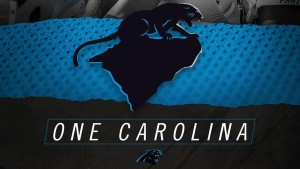
This expansion of the brand identification to an entire region has been paramount in the brand strategy, especially as the team made its way to the most recent Super Bowl and promoted a "One Carolina" marketing campaign, looking to further enhance its uniting powers within the region.
On the other side, trying to cast too wide a brand net can alienate your local audience and be seen as putting their community on the back burner in the eyes of the brand. This is yet another example where research, information-gathering and a sense of awareness to the state of mind around you is the most important aspect of brand development. Knowing the importance of local buy-in and the best way to ensure a connection with the brand can save time and money down the road, and also give your brand a head start in its drive to success.
Image Source 1
Image Source 2
Image Source 3
Why Successfully Building a Brand Starts with Shutting Out the Noise
There are many aspects that go into developing and establishing a successful brand. But they really have nothing to do with it.
That may sound confusing and close to oxymoronic, but it’s true. One of the best moves a brand-building organization can take is to forget all of the substance that goes into building a brand. Once the auxiliary noise is quieted, then finding the perfect note to start the song becomes significantly easier.
But why simplify such a complex process at the very beginning? Well, you try determining a solid brand strategy while simultaneously brainstorming a name and designing a logo and creating a letterhead that will go on a yet-to-be created website that will be included in the on-brand email signatures that will be included in the email sending out the brand standards document to your employees who will need to have a detailed explanation how to live the brand characteristics…
When a brand to-do list starts to resemble a grocery list for Thanksgiving dinner, then it’s time to take a step back and focus on the driving factor, which is identifying the end game – who and what the brand should ultimately become.
Once the final goal is realized, then all subsequent actions and decisions will unite behind a common final destination, and the brand building process will become a synchronized and coordinated effort, instead of falling into the common trap of unfocused branding resulting in a jumbled mess of a brand that needs almost immediate fixing.
The brand naming process can be developed with the full resources available to know what it needs to convey. The same can be applied to the logo creation, the collateral designing and so on, down the line until the full brand has been established.
To carry the musical metaphor along some more, when writing a song, composers don’t begin by determining the exact varying note each different area of the orchestra will play. They begin by finding the foundational chords that will cultivate the song’s melodies and ultimately create the song. Only then, once they know where they want the song to go, do they bring in the building block components that round out the full vision.
The greatest creators had a unique characteristic of singular focus on their task at hand – they could shut out the world around them and devote their attention solely on their creative process, knowing where they wanted to go and not allowing the litany of distractions available divert them from that end goal.
Applying this same mindset and process to your brand building and brand strategy is a tried and true way to ensure that the end brand product is well-rounded and each brand ingredient carries the full potential for the final brand building recipe.


